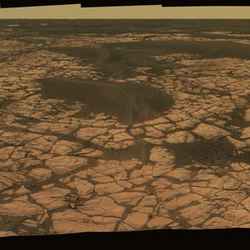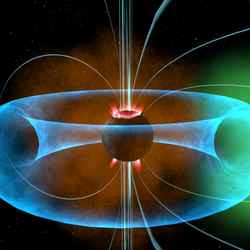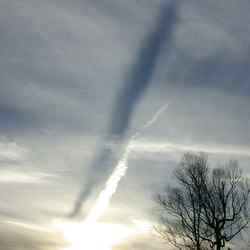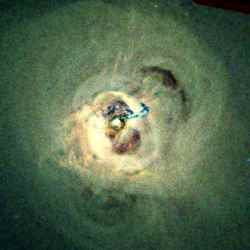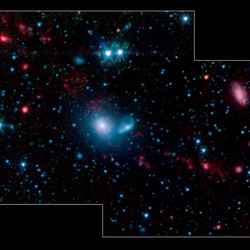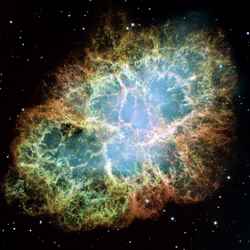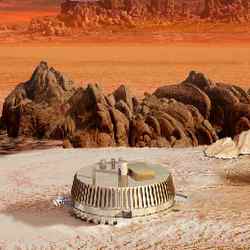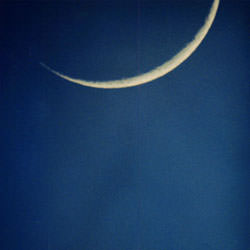
Image credit: Tunc Tezel
Monday, December 5 – For SkyWatchers everywhere, take a look at Venus. Before the week ends, Venus will have reached its greatest brilliancy at -4.6. Now look at the Moon nearby… At its very brightest, it carries a magnitude of -12.6!
Tonight the Moon will offer up a very changeable, sometimes transient, and eventually bright feature on the lunar surface – crater Proclus. At around 28 km (18 miles) in diameter and 2400 meters (11,900 feet) deep, Proclus will appear on the terminator on the west mountainous border of Mare Crisium. Tonight for many viewers, it will seem to be about 2/3 black, but 1/3 of the exposed crater will be exceptionally brilliant – and with good reason. Proclus has an albedo, or surface reflectivity, of about 16%, which is an unusually high value for a lunar feature. Watch this area over the next few nights as two rays from the crater will widen and lengthen, extending approximately 322 km (200 miles) to both the north and south.
Tuesday, December 6 – On the lunar surface tonight, look for the three rings of Theophilus, Cyrillus and Catharina on the edge of Mare Nectaris. Do you remember Dorsum Beaumont? Good! Then let’s head a bit further to the south to check out Fracastorius.
Named for Italian astronomer Girolamo Fracastoro, this 88 kilometer diameter ruined crater will certainly capture your attention. Look carefully at how its northern wall has eroded into the smooth sands of Mare Nectaris, yet a few “lumps” remain to show where it once stood. Fracastorius is a very old crater, mainly filled with lava flow, and has no central peak. With high power and steady seeing, you might glimpse a few small interior craterlets, but you stand a better chance of resolving the small, bright punctuation of Rosse to its northeast.
Wednesday, December 7 – Today is the birthday of Gerard Kuiper. Born 1905, Kuiper was a Dutch-born American planetary scientist who discovered moons of both Uranus and Neptune. He was the first to know that Titan had an atmosphere, and he studied the origins of comets and the solar system.
Tonight we’ll go mountain climbing as we explore the lunar Caucasus. Easily spotted in both binoculars and small telescopes, this mountain range towers around 5182 meters above the surrounding plains – making its peaks as high as Mount Ararat.
As the shadows throw the rugged terrain into bold relief, let’s start by taking a close look at crater Eudoxus in the north – note its rugged walls and a very small central peak. As you begin to move southward along the mountain range, the first small crater you will encounter is tiny Lamech with much more prominent Calippus further south. Now look to the east and you will identify the total ruins of a crater named Alexander. Not very much is left of Alexander except for a shallow arc that marks its south wall. If you haven’t guessed by now, complete this arc in your mind’s eye and you will see how the impact that formed Eudoxus “re-arranged” the lunar landscape!
Thursday, December 8 – Have you been up before dawn lately? If not, why not take a look this morning as Mercury will make its appearance – along with the mighty Jupiter about an hour before dawn!
Tonight on the lunar surface, let’s use a very recognizable feature to help us discover an Astronomical League Lunar Challenge – Cassini and Cassini A.
In the lunar north, the most prominent feature will be the long, dark “scar” of the Alpine Valley running from the northeast to southwest where it enters the Montes Alpes. Follow this mountain chain south to its end at Promontorium Agassiz. To the southwest you will see the singular peak of Mons Piton and to the southeast will be the 57 kilometer wide crater named for Giovanni Cassini. The crater will appear quite shallow: because at 1275 meters deep, it is. Yet, look inside for Cassini A. While it is only 17 kilometers in diameter, it is a stunning 2830 meters deep. Can you spot even smaller Cassini B just inside the crater’s southwest wall?
Friday, December 9 – Southern Hemisphere viewers, you’re in luck tonight as the Puppid-Velid meteor shower reaches its maximum. With an average fall rate of about 10 per hour, this particular meteor shower could also be visible to those far enough south to see the constellation of Puppis. Very little is known about this shower except that the streams and radiants are very tightly bound together. Since studies of the Puppid-Velids are just beginning, why not take the opportunity to watch? Viewing will be all night long and although most of the meteors are faint, it is known to produce an occasional fireball.
While we’re watching, let’s have a look at the lunar surface and use oft-visited crater Eratosthenes to locate other features. Like a yo-yo caught on the end of the string of the Montes Apenninus, Eratosthenes is easy to spot, but did you know the crater north of it in Mare Imbrium is Timocharis? Then look to its east for two small punctuations – Feuillee and Beer. If you return to Timocharis and look for the low rille running southeast you might – with large aperture and steady skies – catch ultra-tiny Pupin in the grey sands. Now let’s go back to Eratosthenes…
Follow the Apennines to the northeast and about a crater width away you will see the very impressive peak of Mons Wolf. While lunar features might not look so large from our vantage point, Mons Wolf is actually as tall as Colorado’s Mt. Zirkel! If placed here on Earth, we’d definitely need time to acclimatize to its summit of 3,658 meters!
Saturday, December 10 – Tonight is the peak of the Monocerid meteor shower. Its fall rate is around 1 per hour and the radiant point is near Gemini.
While you’re looking up, have a look at the “Man in the Moon” tonight. Do you wonder what’s up there? Even binoculars will show you great features like the C-shape of Sinus Iridium and the awesome impacts of Copernicus, Tycho and Clavius. But don’t put away those binoculars just yet…
Tonight Mars will end its backwards, or retrograde, motion against the stars. You’ll find it just a little more than a fistwidth away from the Moon! Now continue onward another handspan away and visit with the incomparable M45 – The Pleiades.
Sunday, December 11 – On this date in 1863, Annie Jump Cannon was born. She was a United States astronomer who created the modern system for classifying stars by their spectra. Tonight let’s celebrate her achievements by viewing some very specific stars that have unusual visual spectral qualities.
Let’s grab a star chart, brush up on our Greek letters and start first with Mu Cephei. Nicknamed the “Garnet Star,” this is perhaps one of the reddest stars visible to the unaided eye. At around 1200 light-years away, this spectral type M2 star will show a delightful blue/purple “flash.” If you still don’t perceive color, try comparing Mu to its bright neighbor Alpha, a spectral type A7, or “white” star. Perhaps you’d like something a bit more off the beaten path? Then head for S Cephei about halfway between Kappa and Gamma toward the pole. Its intense shade of red makes this magnitude 10 star an incredibly worthwhile hunt.
To see an example of a B spectrum star, look no further than the Pleiades… All the components are blue white. Want to taste an “orange?” Then look again at Aldeberan, or Alpha Tauri, and say hello to a K spectrum star. Now that I have your curiosity aroused, would you like to see what our own Sun would look like? Then chose Alpha Aurigae, better known as Capella, and discover a spectral class G star that’s only 160 times brighter intrinsically than the one that holds our solar system together.
If you’re enjoying the game, then have a look at one of the most unusual spectral stars of all – Theta Aurigae. Theta is actually a B class, or a blue/white, but instead of having strong lines in the helium, it has an abnormal concentration of silicon, making this incredibly unusual double star seem to glitter like a “black diamond.”
Still no luck in seeing color? Don’t worry. It does take a bit of practice! The cones in our eyes are the color receptors and when we go out in the dark, the color-blind rods take over. By intensifying the starlight with either a telescope or binoculars, we can usually excite the cones in our dark-adapted eyes to pick up on color.
Tonight is also the peak of the Sigma Hydrid meteor stream. Its radiant is near the head of the Serpent and the fall rate is also 12 per hour – but these are fast!
Until next week, ask for the Moon but keep reaching for the stars! May all your journeys be at light speed…. ~Tammy Plotner
